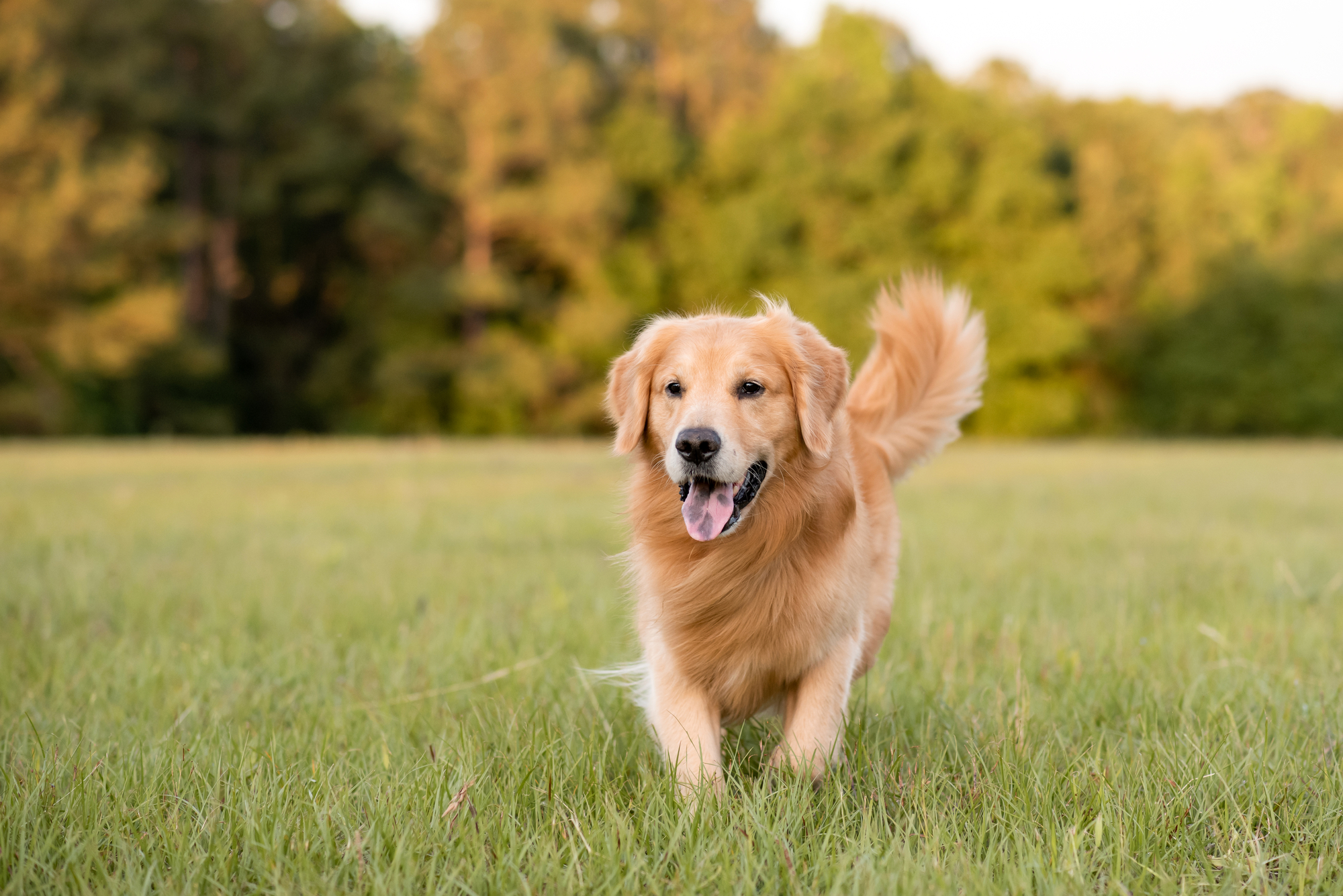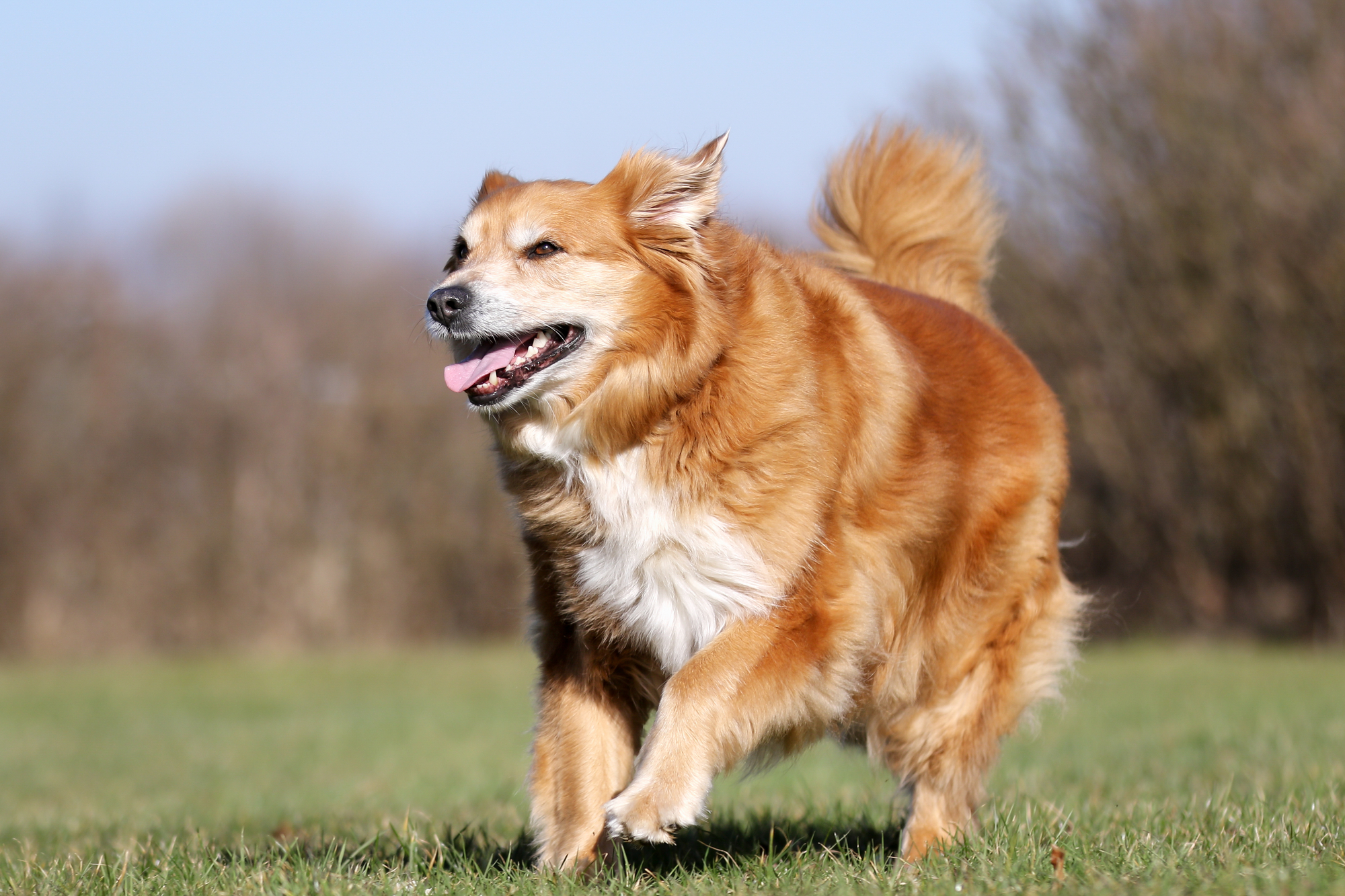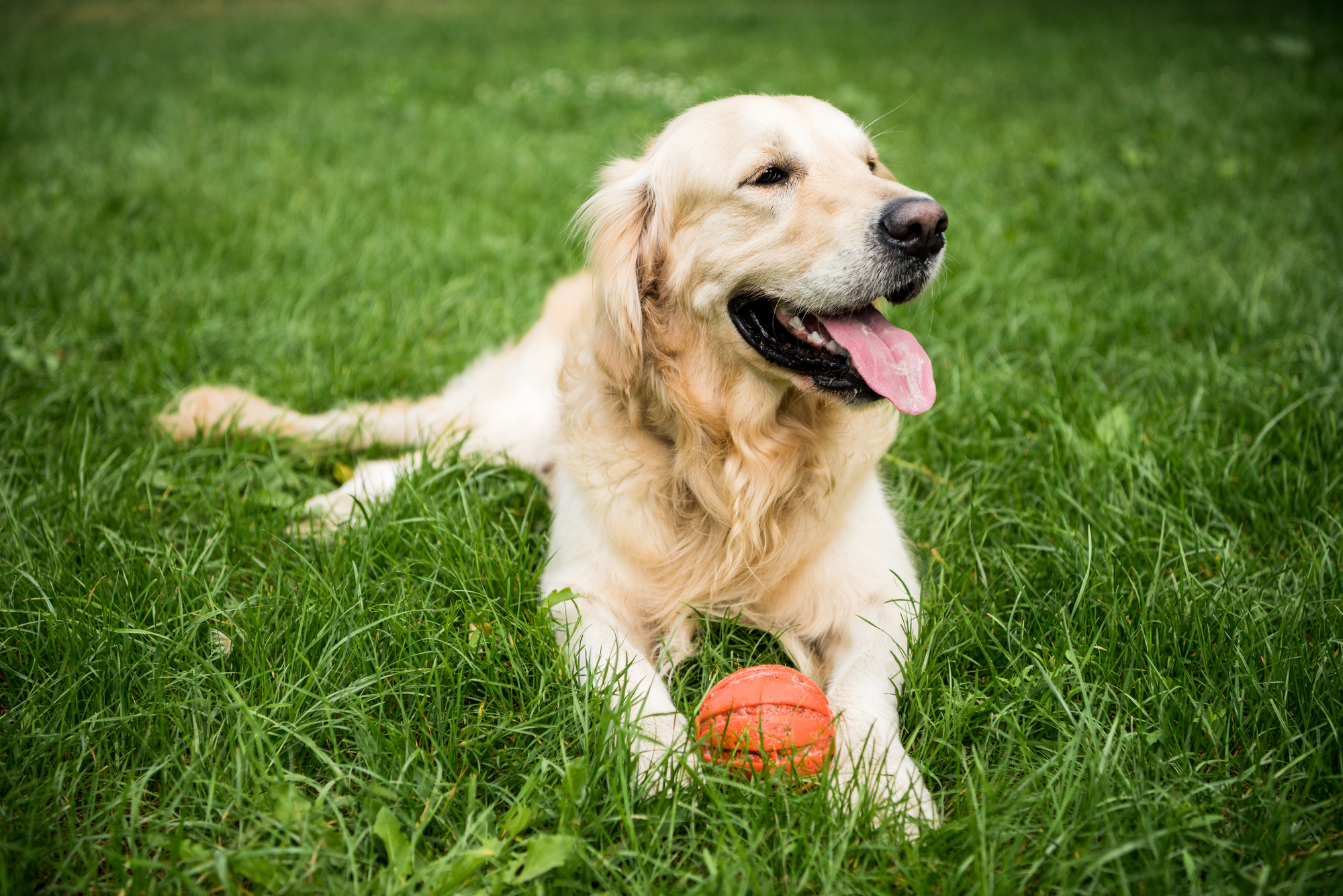Your Cart

Halo is backed by a 90-day satisfaction guarantee
Subtotal$0
Tax & Shipping Calculated at checkout
Total $0
Golden retrievers have long been considered one of the most popular dog breeds, especially as a family pet. However, their intelligence, personality and temperament also make them wonderful working dogs for search and rescue, tracking, contraband detection and assisting the blind or disabled as service dogs. Goldens are highly energetic and remain playfully young at heart well into adulthood but are easily trained due to their eagerness to please. Keep reading to explore valuable breed details on training, grooming, health issues, nutrition and exercise needs to ensure you’re prepared for living with these remarkable companions.
Golden retrievers have long been considered one of the most popular dog breeds, especially as a family pet.

Male: Weight: 65-75 lbs; Height: 23-24 inches
Female: Weight: 55-65 lbs; Height: 21.5-22.5 inches
Yes
Generally good, but should be introduced and socialized early
Make excellent family pets
Easily trained due to high intelligence and natural desire to please
Daily brushing, bathing every 1-2 months
10-12 years
Outgoing, affectionate, loyal, trustworthy, energetic, tolerant
Highly intelligent and trainable, quick learners, friendly, playful
Light gold, gold, dark gold
Adjustable; Fits most dogs

Considered a medium-to-large-sized breed, golden retriever males typically reach 23 to 24 inches in height and weigh between 65 and 75 pounds at full growth. Females tend to be slightly smaller, reaching 21.5 to 22.5 inches and 55 to 65 pounds.
Both sexes have a deep chest, sturdy body and relatively short legs. By age two, this breed should be finished growing. However, males may take another year to reach physical maturity, particularly head development.
Both males and females are famous for their thick, luxurious coats ranging from light to dark gold. Their coat color is where the breed earned its name. However, the feathering under the dog’s body, legs and tail may be lighter than the rest of the coat.
Another notable feature of golden retrievers is their short yet floppy ears, which are V-shaped but rounded on the tips. The flaps flop forward over the ear opening to protect the canal from water and debris. However, they’re still prone to ear infections and require frequent inner ear cleaning.
Purebred golden retrievers usually have dark brown eyes, but some have medium brown. While brown is the most common eye color for dogs of various breeds, the apparent friendliness and intelligence in a golden’s eyes set them apart.
Golden retrievers are intelligent, loyal and eager to please, so they’re typically easy to train. As with all dogs, you should begin training them as puppies, including socialization, to ensure they grow into well-behaved adults. Goldens thrive in a training environment built on clear communication and consistent guidance that focuses on patience and positive reinforcement.
Begin puppy training at 8 weeks and continue through 6 months. You can train your dog yourself or sign up for puppy classes to get help with basic commands, like sit and stay, and tips for continuing training away from classes. Puppy classes also give you a head start on socializing your golden retriever with other dogs and people. However, you must engage in additional socialization in different environments, such as when taking walks and playing in dog parks.
Puppies have limited attention spans, so keep training sessions short. Other tasks to work on include name recognition, leash training, crating, potty training, sound conditioning and alpha positioning. Also establish rules, routines, expectations and boundaries at home. All training should utilize a consistent routine with positive reinforcement such as praise, affection and treats, even as the dog gets older and moves on to more advanced training.
You should begin basic obedience training during early puppy training and continue between ages 6 and 24 months. Obedience training teaches dogs basic manners, how to obey commands and how to behave in various situations. It also helps them feel more comfortable and confident when exploring new environments or meeting new dogs or people.
At 18 to 24 months, you should notice signs of maturity, and basic obedience should be well-ingrained. However, if it isn’t, focus on obedience and performance during this time to redirect undesirable behaviors and ensure you build a solid foundation for a well-behaved canine companion. Consistency is key, so practice commands regularly in different settings to reinforce learning. Gradually increase the difficulty of commands as your golden retriever becomes more adept, setting it up for success with each new challenge.
Goldens are sporting dogs, not herding dogs. Choose athletic activities as part of their advanced training. These activities can occur simultaneously with obedience training and give teenage goldens activities to help burn their excessive energy while learning new things.
Agility and rally training are popular options but shouldn’t be fully started until age 12 to 18 months. These are high-impact sports, so you should only work on tunnel training and agility flatwork until the dog is closer to fully grown. Other advanced training to consider includes barn hunting, field work, dock diving, scent work and additional activities that allow you to work together on increasingly complex tasks.
Training should be a positive, enjoyable experience for you and your dog. While goldens will respond to food-based rewards, their desire to please their humans means they’ll also respond to praise. Negative feedback can impact your dog’s attachment to you and break its confidence, making future training more difficult. Never shout at or scold your golden retriever. Instead, always respond in a calm, confident voice.
Because goldens are so hardworking and eager to please, they may work themselves to the point of collapse. During heavy training, always provide rest breaks and plenty of water to prevent exhaustion. Consider complementing strenuous physical training with mental exercises like puzzle toys to stimulate your golden but allow it to rest while remaining engaged.
Despite their desire to make their humans happy, bored golden retrievers may misbehave. They don’t do well when left alone for long periods and become unhappy if they aren’t well exercised. Keeping your golden busy helps prevent bad behavior and strengthens your bond.
Obedience training is important, but giving your dog freedom and space while keeping them safe is also important. Training your dog to stay inside a GPS dog fence is a great way to enjoy off leash time outdoors with your dog, while ensuring they are safe at all times.
Golden retrievers have a thick, medium-length double coat that’s water-resistant. They’re known as moderate-to-heavy shedders and need regular brushing. During heavy shedding periods about once or twice a year, they may require daily brushing to remove dead hair and keep your home from becoming covered in hair. Outside these periods, they continuously shed on a moderate level, but brushing 3-5 times per week should suffice.
The American Kennel Club recommends a pin brush over a bristle version to get through this breed’s thick coat. Watch for tangles or matted hair. Never try to forcibly untangle hair, which can cause significant pain to the dog’s skin. Instead, use a detangling spray to gently work the tangles out. For severe mats close to the skin, you may need to contact a professional groomer to ensure you don’t injure your dog.
Inadequate grooming can prevent new hair from growing due to a buildup of dead skin cells in the fur, causing the dog to lose its soft, shiny coat. If the fur becomes extremely matted and tangled, it can potentially lead to itchy, painful skin lesions called hot spots.
Golden retrievers should be brushed before and after bathing, which should occur about every 1-2 months. When bathing, wet your dog down to the skin before applying a canine-specific shampoo and conditioner. Due to their double coat, golden retrievers must be rinsed twice to ensure the hair doesn’t retain shampoo. Dry your dog thoroughly with a towel. You can also use a canine hair dryer, which runs cooler than a human version, to prevent burning the hair or skin.
A golden retriever’s double coat protects its skin from the sun, moisture and hot and cold temperatures. Never clip or shave the fur because you think it will make it more comfortable in hot weather. In reality, you’re compromising its body’s natural protection and putting it at greater risk of skin problems, including cancer. You can use thinning scissors to trim the feathers under the dog’s body, legs and tail, but avoid clipping these as well.
Golden retrievers also need the hair between the pads on the bottom of their feet trimmed regularly to maintain traction on slippery surfaces. Trim their nails with canine-appropriate clippers or a nail grinder about once a month to reduce the risk of snagging and tearing. If you take your dog to a professional groomer for coat and foot care, the AKC suggests scheduling appointments every 4-6 weeks.
Although golden retrievers are generally a healthy breed, they’re prone to various conditions and predisposed to others due to their genetic makeup. It’s crucial to schedule regular veterinary checkups to catch common health issues early.
As puppies, goldens are susceptible to common illnesses, such as parvovirus, distemper, kennel cough and leptospirosis, until they have all their vaccinations. As they age, they’re prone to hot spots due to their thick coats and love of swimming. They’re also genetically predisposed to atopic dermatitis, an extremely itchy skin condition that usually develops between ages 2 and 6 years and is triggered by environmental or food allergies.
Golden retrievers are prone to ear infections, but you can prevent them by cleaning their ears weekly with an ear-cleansing solution. They’re also vulnerable to eye issues like progressive retinal atrophy, which causes blindness, and pigmentary uveitis, an inherited condition that causes eye cysts to develop.
You should routinely screen your golden for hip dysplasia and elbow dysplasia, which are inherited orthopedic conditions. Both may be managed with joint supplements and/or anti-inflammatory and pain medications, but these conditions sometimes require surgical intervention. They’re also predisposed to hypothyroidism, typically developing in middle age, but it can be managed well with lifelong medication.
Golden retriever puppies can inherit subaortic stenosis from their parents. This genetic heart condition occurs during the first year of the dog’s life and can lead to heart damage or, in severe cases, sudden death. Responsible breeding can prevent this condition.
Unfortunately, these dogs have a high rate of cancer, though it’s not fully understood why. Theories abound as to the increased cancer risk, including their size, longer lifespans due to immunizations and a cancer-causing gene in their genetic makeup. While 25% of all dogs will develop some form of cancer, studies have shown that 60% of goldens are impacted. Lymphoma, hemangiosarcoma, osteosarcoma and mast cell tumors are common forms affecting golden retrievers. Their cancer risk increases at 6 and peaks between 10 and 12 years of age.

Goldens love to eat, including things they shouldn’t such as paper, socks and toys. They also tend to overeat, so you must limit their treats, measure out their food and only feed them during regular mealtimes.
Feed your golden retriever a high-quality, large-breed puppy formula from 8 weeks up to 12 to 18 months of age. Puppies’ rapid growth spurts require extra calories to help them reach their full potential. They should eat about three or four times per day.
Once it reaches maturity, transition your golden to a high-quality, large-breed adult formula. As adults, they should only eat twice a day, in the morning and evening. Because they tend to eat fast, consider using a slow feeder bowl to prevent digestion issues, including vomiting and bloat. Around age 7, or whenever your dog starts slowing down, consider switching to a senior formula.
Always read the feeding instructions on dog food to determine the appropriate amount to provide based on weight and activity level. However, these instructions are merely guidelines. Adjust their food intake accordingly if your dog is losing or gaining too much weight. Talk to your veterinarian if you need help choosing the best food or determining how much to feed your golden to maintain a healthy weight.
Choosing the appropriate food for the dog’s life stage helps ensure a complete, balanced diet that contains the correct ratios of all the required nutrients. However, you may want to start your golden retriever on a joint supplement early in life to slow down or potentially prevent arthritis and an omega-3 fatty acid, such as fish oil, to reduce joint inflammation and skin conditions. Always talk to your vet before adding supplements to your dog’s diet.
Goldens are active sporting dogs and need lots of exercise. Because they’re built to retrieve waterfowl for extended periods, swimming and fetching are natural activities for golden retrievers. They also enjoy long walks or runs and playing fetch. Agility and obedience training, dock diving and tracking are other activities this breed usually enjoys.
Because they’re highly energetic and enjoy playing outdoors, having a large yard or making regular visits to an off-leash dog park is crucial to ensure they receive enough physical stimulation. Once they reach adulthood, anticipate 1-2 hours of walks each day, supplemented with more intensive exercise to keep them in peak shape.
Golden retrievers are also highly intelligent, so they need daily mental stimulation. Activities they enjoy include playing with puzzles or toys, hide-and-seek, scenting games, learning new tricks and visiting new places while you run errands.

Golden retrievers usually have a sweet, puppy-like temperament, making them excellent playmates for family members of all ages. When socialized as puppies, they’re friendly toward children, other pets and even strangers. Their tendency to be friendly to anyone they encounter makes them poor choices as guard dogs but extremely popular as family pets.
Because they have lots of energy, goldens require lots of exercise to remain happy and healthy. They love being outdoors, so they generally feel more comfortable if they have a large backyard to romp in. However, they can adapt to smaller spaces, including apartment living, if they have plenty of daily exercise, especially long walks.
Goldens are considered quiet because they bark infrequently and aren’t known for digging up yards. These traits are also beneficial if you live in an apartment or another housing situation in which you’re close to neighbors or have roommates.
Living with a golden retriever is great overall due to its friendly, affectionate nature. This breed’s intelligence and trainability further ensure a rewarding relationship for individuals and families alike.
Golden retrievers are generally playful yet gentle and tolerant toward children if appropriately socialized as puppies. However, you should still supervise them, especially with young children, to ensure safe interactions and teach the dog and child appropriate boundaries and behaviors.
Healthy adult golden retrievers are active, energetic dogs that generally need 1.5 to 2 hours of daily exercise, broken up over multiple sessions to prevent boredom and keep them at peak performance. A good way to track your dog’s activity is with a GPS dog collar. In addition to setting up a safe perimeter for your dog, you can check the app to see how much exercise your Golden gets every day.
Golden retrievers require relatively intensive grooming due to their thick, double-coat and because they’re moderate-to-heavy shedders. Daily brushing may be needed during heavy shedding periods, but 3-5 times per week should suffice at other times. Bathing should occur every 1-2 months, with nail trimming about once a month. Professional grooming appointments every 4-6 weeks are recommended.
Golden retrievers are highly intelligent, eager to please, willing to obey commands and considered easy to train. While their intelligence makes it easy for them to learn, it may also cause them to become easily bored or frustrated. If this occurs, it might be challenging to keep your golden’s attention during training.
Golden retrievers are generally healthy but prone to various genetic conditions. Common issues include hip and elbow dysplasia, ear infections, eye conditions such as progressive retinal atrophy and heart conditions such as subaortic stenosis. Additionally, they have a higher-than-average cancer risk. Regular vet checkups are crucial to catch health issues as early as possible for more positive outcomes.
The average lifespan of a golden retriever is 10-12 years. However, their predisposition to various serious health conditions, most notably cancer, can cut their lives short. Studies show 60% of goldens die from cancer, making it a significant factor contributing to their shortened lifespan.
If a golden retriever receives proper socialization, it typically gets along well with other dogs and pets. They’re not prone to aggression toward other animals and are known to be gentle and friendly in normal situations.
Golden retrievers are very energetic and love being outdoors, so they’re best suited to living in a house with a large yard. However, they’re adaptable to apartment living if their owner takes them on long walks and exercises them daily.
Golden retrievers are usually considered a good breed for first-time dog owners because they’re easy to train. However, grooming responsibilities can be intense, especially during heavy shedding seasons, and they require a significant amount of exercise. Potential dog owners should have ample time to care for and interact with this breed.
Feed your golden retriever a high-quality, large-breed puppy formula about three to four times daily until age 12-18 months, then switch to an adult formula and feed it twice per day. Consider switching to a senior formula around age 7 or when it begins slowing down. Adjust portions based on weight and activity level, and add supplements with your vet’s guidance.

Golden Retrievers are truly man’s best friend, and you want to give your dog the best life possible. Halo Collar is a wireless GPS fence with a convenient phone app that allows you to set up a safe perimeter for your dog at home, on walks, or anywhere you take your pup. It also acts as an activity tracker and training aid for your Golden, providing several convenient benefits in one. Shop for your Halo Collar today.

Halo is backed by a 90-day satisfaction guarantee
Subtotal$0
Tax & Shipping Calculated at checkout
Total $0